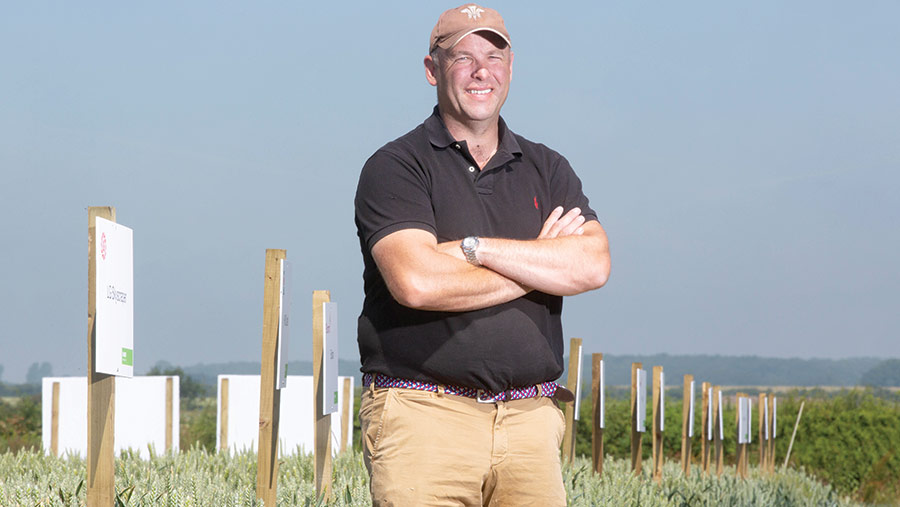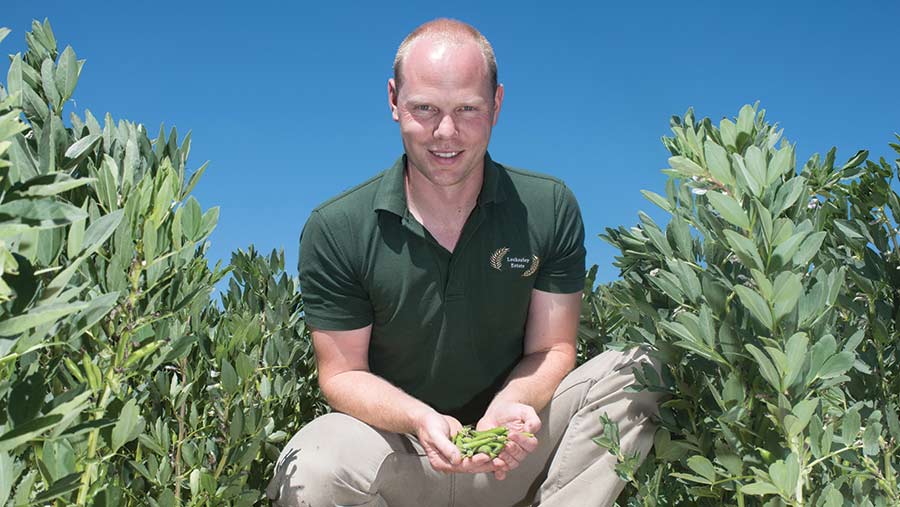Farmers Weekly Awards – Arable Farmer finalists 2018
What does it take to get arable businesses in better shape to face the challenges of Brexit in the years to come?
All three of our finalists see better soil health has a key role and this is at the heart of their impressive achievements in cropping efficiency.
The 2018 Farmers Weekly Arable Farmer finalists:
- Brian Barker, Lodge Farm, Stowmarket, Suffolk
- Russell McKenzie, Howsons Lodge, Huntingdon, Cambridgeshire
- Craig Livingstone, Lockerley Estate, East Tytherley, Hampshire
The judges:
-
- Shaun Watson, last year’s winner
- Richard Allison, Farmers Weekly arable editor
- Andrew Blazey, independent judge
Brian Barker

Brian Barker © Tim Scrivener
Brian Barker’s love of spreadsheets is enabling him to make full use of field data when choosing his fertiliser and fungicide inputs for his wheat.
His novel approach means every field of wheat receives a tailored programme of inputs based on its yield potential, with higher-yielding crops getting more.
See also: How one OSR grower is benefitting from companion crops
“We are effectively assessing the real-time state of the farm and then making decisions based on crop needs,” he explains.
For example, there is no point applying more fertiliser if there are not enough plants there to use it.
Challenge
Brian recalls that several years ago, the family business was operating a traditional Suffolk clay cereal-based rotation with extensive cultivations.
Farm facts
- 513ha of arable cropping on heavy soils
- Cropping includes winter wheat, spring barley, spring linseed, spring beans and herbage
- Establishment kit consists of Sumo DD and a Sumo DTS, as well as plough and min-till options
- Three full-time staff
“We were delivering high yields and good-quality crops, but the costs were excessive.”
Three years ago, the business reached tipping point, with an ageing machinery fleet and the loss of some contract farming area leaving the farm overequipped.
It was during this time that Brian joined the AHDB Monitor Farm programme, with the aim of putting together a plan to get the business in shape for life after Brexit.
He also wanted to reduce the true cost of wheat production to less than £100/t.
Changes
The first change was to adopt a less-intensive establishment system. He opted for two systems – a direct drill and a strip-till drill.
This was also the ideal time to gain a better understanding of variations between fields by building his own database. Brian wanted to better predict crop potential and then invest the inputs accordingly.
Based on the AHDB blueprint for an 11t/ha wheat crop, he worked backwards to find the ideal seed rates, tiller numbers and head counts, and now benchmarks his fields through the season.
Armed with this data, he ranks fields on potential yield, marking them red, amber or green to indicate the level of fertiliser and fungicide inputs.
The result is that Brian is managing risk and inputs according to potential rather than using the blanket approach seen on most farms.
Brian has made other changes such as dropping oilseed rape, as it did not stack up financially, and selecting wheat varieties based on disease resistance ratings.
He is also hitting blackgrass hard, taking bad areas out of wheat for four years and adopting a linseed-hybrid barley-linseed-hybrid barley rotation in a bid to take out the early- and late-germinating populations of the weed.
Achievements
The result of the changes is that the cost of producing wheat fell from £236/t in 2015 to £92/t in 2017. Part of this is due to the average field establishment cost falling from £239/ha to £87/ha.
The increased accuracy of the final nitrogen dose means he is saving on fertiliser, equating to £3,500 of SingleTop last season.
He is also learning from his data – for example, in a wet spring like 2018, solid prills work better than liquid fertiliser.
Brian is now taking it a step further and has set up a local yield club of 18 farmers. This allows him to benchmark against other farms, as well as help others take a similar approach.
It’s not just crops: he also has a passion for wildlife and has taken 12% of the farm area out of production. These are poorer-yielding areas that were more difficult to farm.
In conclusion, Brian has created a business that is more resilient for life after Brexit.
He believes it serves as a blueprint for Defra’s Health and Harmony vision, with an intensive cropping business alongside dedicated areas for wildlife paid for by environmental schemes.
The judges liked…
- Enthusiasm and drive to improve cropping efficiency
- Very cost-aware – knows all his costs of production
- Incentivises staff with profit share on contracting element
- An intensive approach to both arable and environmental areas on the farm
- Good public interaction on and off farm
What the judges say:
“Brian shows great enthusiasm for increasing crop efficiency by making extensive use of data. He has an excellent awareness of his costs and is promoting arable farming to the public.”
Russell McKenzie

Russell McKenzie © Tim Scrivener
Russell McKenzie likes to think “Innovation” is his middle name, given his passion for trying out new varieties and pesticides.
“Sadly,” he confesses, “it’s Bryan.”
He is a champion of on-farm trials, hosting several in any one season, giving him early access to new products.
Russell is part of Basf’s Real Results Circle network, hosts a Bayer variety trial, and he has completed a three-year stint as an AHDB Monitor Farmer.
This access to the latest technology and approaches has helped him to drive up crop performance across 995ha of largely heavy clay soils within a 17-mile area straddling Cambridgeshire, Bedfordshire and Northamptonshire.
Challenges
Like many in the area, running a tight winter wheat-oilseed rape rotation on heavy clay meant blackgrass had become a problem in some fields.
Farm Facts
- 995ha of arable cropping on mainly heavy clay soils
- Cropping includes winter wheat, oilseed rape, winter and spring barley, oats plus winter and spring beans
- Crops direct-drilled using Horsch Sprinter with Dutch Openers
- Three full-time staff
Battling the grassweed added to input costs, and the previous establishment system also made heavy use of diesel and machinery.
Furthermore, flea beetle had become a problem, putting in doubt the future of oilseed rape – a valuable break crop – in the rotation.
He constantly strives to push yields further. His philosophy is not to become complacent despite good achievements.
Changes
The key change was the move to direct drilling using a Horsch Sprinter drill with Dutch Openers, as there was too much deep cultivation and it was not creating the quality seed beds needed for good establishment.
He was convinced of the move after carrying out a trial – one half of a field was ploughed and the other half was direct drilled.
“The ploughed area pressed OK, but it lost moisture and the crop took longer to establish. In the end, the direct-drilled area outyielded the ploughed area,” he says.
Spring cropping has been introduced in a bid to tackle blackgrass and a double hit of spring barley and spring oats is proving particularly effective.
This move to spring cropping also filled the gap created by the smaller oilseed rape area.
Variety choice is now more focused on disease resistance, and adopting variable-rate seeding has led to more even crops.
Achievements
The standout achievement is that yields have risen by 2.55t/ha to 11.05t/ha for wheat, while oilseed rape yields rose by three-quarters of a tonne, despite the flea beetle onslaught.
Herbicide costs have fallen as blackgrass has become more manageable through wider use of spring cropping, from £130-£150/ha to less than £90/ha.
Russell is adding value where possible, growing milling wheats and seed crops. One advantage of growing crops for seed is that he sees varieties a year or so early and so can capitalise early on their benefits.
He has also cut machinery costs – diesel use has fallen by 1,700 litres a year, which is a huge saving. However, he is not prepared to scrimp on inputs.
“You can’t compromise too much on fungicides and herbicides with a high-input, high-output system,” he says
Better soil health means he is using less fertiliser, having achieved a yield of 13t/ha with 190kg N/ha and hitting 13% protein. Soils also hold moisture longer and don’t see water standing on the surface.
The result is that he has achieved the impossible; increasing wheat yields while at the same time reducing costs, producing wheat for £92/t.
The judges liked…
- Good-looking crops and not afraid to invest in inputs
- Successfully manages land several miles apart
- Interested in trials and willing to adopt new varieties and technology
- Prepared to take time to get soils right
What the judges say:
“Not coming from a farming background, it is quite an achievement to be managing crops at this high level. Russell is not afraid to invest in crop inputs and try new approaches.”
Craig Livingstone

Craig Livingstone © Hugh Nutt
Starting from scratch and building a top arable team is a daunting task, but it’s something Craig Livingstone has relished.
Craig has worked at Lockerley Estate in Hampshire for nearly three years and prior to joining, the arable cropping was largely managed using external contractors and advisers.
The owners then decided to bring it back in house, and that is where Craig fits in.
The former agronomist wanted to get back into practical farming and he is now using his expertise to get the most from the highly variable soils in this corner of Hampshire.
Challenges
One problem when relying on spraying contractors is that fungicide and herbicide applications are not always timely.
Farm Facts
- 800ha of arable cropping on contrasting chalk and clay Hampshire soils
- Cropping includes winter wheat, winter barley, oilseed rape, winter oats, spring beans and spring barley
- Establishment kit consists of Vaderstad TopDown, Vaderstad Carrier and a Vaderstad Rapid drill
- Five full-time, one part-time staff, shared with forestry and shoot enterprises
He says the machinery fleet was tired and running and repair costs were high.
Soil health was also declining, which he describes as “not great”, as the estate no longer had dairy cattle.
While blackgrass is a scourge on many farms, it is not a major problem at East Tytherley. Instead his two weed challenges are charlock in oilseed rape and brome.
Infrastructure was also absent – Craig recalls seeing the farmyard for the first time with no real buildings. He also needed to build an arable team.
Changes
The oilseed rape area has halved and spring beans, winter barley and winter oats were added to widen the rotation to six years.
A key change was to go shallower with the min-till cultivations. One valuable addition to the fleet is a Carrier L with cross-cutters, which can run very shallow if needed. This, in addition to the Top Down and Rapid, gives flexibility – essential with soils ranging from clay to shallow chalk
Craig is nursing soils back to health, with lime added as well as liberal amounts of organic matter. He is a firm believer in cover crops, which also have a role with the move to more spring cropping.
He has adopted precision technology, with P and K fertiliser applied variably, as well as seeding, which has evened up crops. In one trial he saw a 28% loss of plants when he was not using the variable approach.
The estate invested in a 30m trailed sprayer and trained two members of staff, which enabled more timely treatments. In fact, there has been an emphasis on training staff so they have the skills to do multiple roles.
Achievements
Crop yields have increased, with wheat up 1.8t/ha, oilseed rape approaching 4t/ha and winter oats now at 7.8t/ha, the latter grown for Morning Foods.
A shallower approach to cultivations has slashed fuel costs and it has helped Craig reduce the cost of producing wheat to about £90/t.
Input costs have fallen too. The greater emphasis on selecting varieties on disease score combined with a wider six-year rotation has resulted in a 17% reduction in agrochemical spend.
The new grain store means he has more control over marketing and can wait for better prices if needed. He is adding value by growing malting barley, soft Group 3 wheat and Group 2 milling varieties.
Craig recognises the increasing role of technology and is hosting trials of three robots, as well as being part of a Rothamsted project that looks at using satellite data to predict yields.
He believes in spreading the word and is a member of Face, going into his local school to tell kids about crops.
Nearly three years on, the farm is on a more sustainable footing and he has a well-motivated team. An indicator of his success is that two neighbours have approached him to farm their areas.
The judges liked…
- Strong vision and achieved much in three years
- Built a strong team, upskilling existing estate staff and recruiting a new member
- Marketing using mix of his own selling, pools and contracts
- Grows good-looking crops and achieves good yields on some very variable land
- Good attention to detail, always looking for marginal gains to improve overall performance
What the judges say:
“Heading into his third harvest, Craig has achieved a lot in a short time. He shows great passion and pride in what he is doing and has built up a capable and well-motivated team.”
Sponsor’s message
 Arable farming involves a range of skills. From understanding end-user customers and the supply-chain’s importance to practising good agronomy that protects crops and the environment, these finalists demonstrate growing crops can be profitable and good for wildlife.
Arable farming involves a range of skills. From understanding end-user customers and the supply-chain’s importance to practising good agronomy that protects crops and the environment, these finalists demonstrate growing crops can be profitable and good for wildlife.
Andrew Newby, managing director, KWS UK

